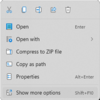I have this weird love/hate relationship with VMware Workstation Pro. I'm trying to permanently part ways with VMware and switch over to Hyper-V. Unfortunately, there is one big issue with that plan ...
I have 42 (!) VMware Workstation configs saved on my system that are all activated with Win 10 or Win 11. I've spent about 3 hours trying to convert some VMware VMs to Hyper-V and only managed to successfully convert one machine. Here is what I am doing:
I install Win 10 or Win 11 on a VMware Virtual Machine and ensure that it successfully activates. I then create a disk image backup of that VM and restore it to a Hyper-V machine. I run the troubleshooter to tell it that I have recently changed hardware. This fails saying that this operation is not valid for this type of machine. I suppose it is complaining about the fact that it is a VM and not a physical machine. I know that this works for a physical machine, but it seems to fail on VMs.
As I noted earlier, I did manage to get one VM to convert. I have no idea why that one worked vs the others which fail. Clearly, there must be some difference.
Anyone have any tips or suggestions?
I really want to get away from VMware Workstation, but not if I have to abandon 42 activated machines.
NOTE: Before anyone asks, I know that by telling you that I have 42 activated machines you are going to think that I somehow have illegitimate activations. I can ensure you that every one of these is a legally, legitimately activated VM!
I have 42 (!) VMware Workstation configs saved on my system that are all activated with Win 10 or Win 11. I've spent about 3 hours trying to convert some VMware VMs to Hyper-V and only managed to successfully convert one machine. Here is what I am doing:
I install Win 10 or Win 11 on a VMware Virtual Machine and ensure that it successfully activates. I then create a disk image backup of that VM and restore it to a Hyper-V machine. I run the troubleshooter to tell it that I have recently changed hardware. This fails saying that this operation is not valid for this type of machine. I suppose it is complaining about the fact that it is a VM and not a physical machine. I know that this works for a physical machine, but it seems to fail on VMs.
As I noted earlier, I did manage to get one VM to convert. I have no idea why that one worked vs the others which fail. Clearly, there must be some difference.
Anyone have any tips or suggestions?
I really want to get away from VMware Workstation, but not if I have to abandon 42 activated machines.
NOTE: Before anyone asks, I know that by telling you that I have 42 activated machines you are going to think that I somehow have illegitimate activations. I can ensure you that every one of these is a legally, legitimately activated VM!
My Computers
System One System Two
-
- OS
- Win11 Pro 23H2
- Computer type
- PC/Desktop
- Manufacturer/Model
- Home Built
- CPU
- Intel i7-11700K
- Motherboard
- ASUS Prime Z590-A
- Memory
- 128GB Crucial Ballistix 3200MHz DRAM
- Graphics Card(s)
- No GPU - CPU graphics only (for now)
- Sound Card
- Realtek (on motherboard)
- Monitor(s) Displays
- HP Envy 32
- Screen Resolution
- 2560 x 1440
- Hard Drives
- 1 x 1TB NVMe Gen 4 x 4 SSD
1 x 2TB NVMe Gen 3 x 4 SSD
2 x 512GB 2.5" SSDs
2 x 8TB HD
- PSU
- Corsair HX850i
- Case
- Corsair iCue 5000X RGB
- Cooling
- Noctua NH-D15 chromax.black cooler + 10 case fans
- Keyboard
- CODE backlit mechanical keyboard
- Mouse
- Logitech MX Master 3
- Internet Speed
- 1Gb Up / 1 Gb Down
- Browser
- Edge
- Antivirus
- Windows Defender
- Other Info
- Additional options installed:
WiFi 6E PCIe adapter
ASUS ThunderboltEX 4 PCIe adapter
-
- Operating System
- Win11 Pro 23H2
- Computer type
- Laptop
- Manufacturer/Model
- Lenovo ThinkBook 13x Gen 2
- CPU
- Intel i7-1255U
- Memory
- 16 GB
- Graphics card(s)
- Intel Iris Xe Graphics
- Sound Card
- Realtek® ALC3306-CG codec
- Monitor(s) Displays
- 13.3-inch IPS Display
- Screen Resolution
- WQXGA (2560 x 1600)
- Hard Drives
- 2 TB 4 x 4 NVMe SSD
- PSU
- USB-C / Thunderbolt 4 Power / Charging
- Mouse
- Buttonless Glass Precision Touchpad
- Keyboard
- Backlit, spill resistant keyboard
- Internet Speed
- 1Gb Up / 1Gb Down
- Browser
- Edge
- Antivirus
- Windows Defender
- Other Info
- WiFi 6e / Bluetooth 5.1 / Facial Recognition / Fingerprint Sensor / ToF (Time of Flight) Human Presence Sensor

















